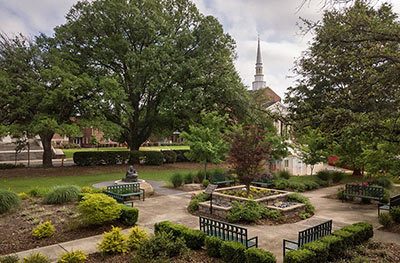Early 20th Century
Enrollment climbed to 400 students during the Provine presidency and the endowment grew to more than $500,000. Mississippi College landmarks like Jennings Hall opened in 1907, and it was considered among the most elegant residence halls in the South. It was heated with steam, and students bragged about having an electric light in every room! The dormitory provided meals in a well-furnished dining hall. Today, Jennings remains a splendid headquarters for faculty offices, classrooms and houses delightful fountains in its renovated courtyard.
After the Roaring 20s, there were enormous financial challenges facing Mississippi College, all of American higher education and the business world. Shaking America’s foundations, and creating widespread poverty for millions of people in big cities and small towns, Mississippi College survived the ravages of the Great Depression that began in 1929 and lingered for well over a decade. Mississippi College students at times made tuition payments with a wagonload of potatoes. Gifts of land, houses, and other resources were welcomed, along with cash at the Baptist school. It was the same way during the difficult years of Reconstruction. Despite adversity Hillman College prospered in the late 1920s, with two brick cottages built for a dozen female students and a faculty member on the Clinton campus. The good times didn’t last with Hillman consolidating with Mississippi College in 1942.
Post World War II and Early 21st Century
Combined with the influx of women was a post-World War II enrollment boom with many G.I. vets returning from overseas battles to receive a college education in Clinton, Mississippi.
While the Hillman campus no longer exists today other than a marker at a Clinton park, many notable MC buildings are alive and well in the early 21st Century. Constructed in 1925, multi-purpose facilities like Alumni Hall are still going strong in 2013. Alumni Hall includes an indoor water fitness pool, student gathering spots with large flat-screen Tvs, a basketball court, coffee shop, conference rooms for the Board of Trustees and a student counseling center. Longtime college dormitories like Chrestman Hall and Ratliff Hall continue to receive extensive use. The Leland Speed Library, Self Hall, home of the School of Business, and Aven Fine Arts Building, home of musical and theater productions, have undergone extensive renovations.
Mississippi College’s administrative home and auditorium that was built in 1948, Nelson Hall continues to be a cornerstone of the Christian university. Buildings in downtown Jackson that serve as the home of the university’s School of Law (purchased in 1975) also take a prominent place in Mississippi College history books. The construction of Cockroft Hall, home of the School of Nursing, the A.E. Wood Coliseum, the university’s basketball arena, and setting for today’s graduation ceremonies, and the list goes on.
From new buildings to new academic programs, from successful fund drives to the hiring of award-winning faculty and the latest computer technology purchases, Mississippi College has experienced tremendous advances under its presidents in the modern era. Presidents D.M. Nelson, R.A. McLemore, Lewis Nobles, Howell Todd and Lee Royce can all point to accomplishments.
Under the guidance of its leaders at Nelson Hall, a caring faculty and staff, and enriched by God’s many blessings, Mississippi College has emerged from humble beginnings to become as one of the South’s premier Christian universities, with a bright future still to come.


